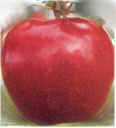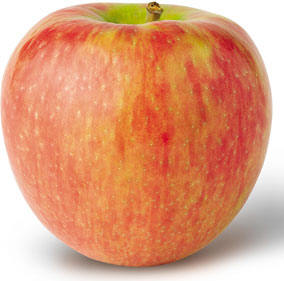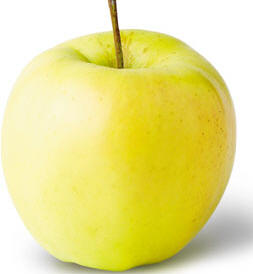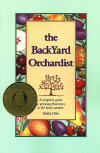|
antique or heirloom variety
FRUIT LIST LINKS
Ordering Info & Guarantee Policy
Home Orchard Spray Schedule & Supplies
"Even if I knew that tomorrow the world would go to pieces, I would still plant my apple tree." Martin Luther (1500'S)
TRIVIA: In ancient Greece, tossing an apple to a girl was a traditional proposal of marriage; catching it was an indication of acceptance.
|
APPLES & CRABAPPLES The plant nursery has closed for retirement. Bill Ford is available for consultation and presentations. Call 706-273-8295 Please feel free to use the following pages for reference. We thank you for your pratronage through the last 26 years. Happy gardening!
Anna
A great low chill apple from Israel for our
customer in Zones8-9. Anna has excellent quality with just enough tartness for fresh
eating as well as cooking. A large red blushed apple that is a spur type so it will bear
earlier in age and heavily. Ripens Late June. Zones 8-9.
Adams Red
Crisp, juicy, very white flesh that is more coarser than fine. Beautiful glossy
red with deep purplish streaks. It's characteristic conical shape tapers down to prominent bumps
or chins at it's base. (This is the apple the witch gave to Snow White.
Ripens Mid-Late September.
Zones 5-9.
Arkansas Black
Medium to large apple with dark red to
sometimes black color with smooth waxy finish. Flesh is yellow and very
firm with an aromatic flavor. Good storage life. Bears early in
age. Ripens Mid-October. Zones 5-8.
Ben Davis
Once a commercial variety in the US. Large attractive fruit.
Bright red over yellow. Firm, course white
flesh with red blush over green skin. Consistent producer and great
Winter Keeper. Excellent for cooking
Mid October Zones 6-8
Big Green
Super large greenish apple with a carmine blush. Crisp, slightly tart white flesh that's crunchy and bruise resistant. Ripens first part of October.
Zones 5-8.
A newer apple that is creating a lot of
interest at the markets! The fruit are beautiful with a bright red
striping over yellow. The great sweet-tart flavor seems to get better
with age, so stores very well. Use for fresh eating, cooking, cider, and
drying. Ripens in mid October. Zones 4-8.
Cox Pippin
Detroit Red
Zones 5-8.
Empire Medium size apple,
cross between McIntosh and Delicious that produces solid red
fruit that is sweet with slightly tart flavor.
Fruit is firm, with an excellent storage life. Good
for fresh eating, cider, sauce, cooking, and freezing. Ripens first of
September. Zones 5-8.
Enterprise
Freedom
Ripens mid-late September.
Zones 5-9.
Fuji - Red
An exceedingly popular apple that sells out
quickly at local apple houses. Medium size fruit have a red color over
yellow striping. Flesh is firm and crunchy with a sweetness and acid
flavor. Excellent storage life. Great for eating fresh & salads as well
as for pies & sauce. Ripens mid Oct.
Zones 5-8.
Gala
Gala's popularity is growing in the markets
as more people try it and get hooked. The coloring is a mix of red,
yellow and orange stripping. This wonderful summer apple has crisp
flesh, which is juicy and sweet. Used for fresh eating and cooking, and
stores well. Ripens early to late August. Zones 5-8.
Galarina
®
(PPAF X-4982 Cltv.)
(Pollinator) Galarina is a new
French variety that is a Gala cross with all the wonderful qualities of Gala yet
with more disease resistance. The striped red fruit are crispy with a sweet flavor.
They store well keeping their crispness and flavor for fresh eating, salads and cooking.
The hardy tree has an upright-spreading habit, with pink fragrant blooms that start
opening early and into mid-season. Ripens mid-late August. Zones 4-8.
Ginger Gold
®
(PP #7063)
(Pollinator)
Golden Delicious
(Gibson strain)
(Pollinator)
Put off by the Goldens that you find in the
supermarket? Ours are much crisper! This large yellow apple is your
all-around apple. They are great for fresh eating, cooking, sauce, juice
and cider. Ripens mid-late September. Zones 5-9a.
GoldRush
®
(PP# 9932)
Horse
A
complete guide to growing fruit trees in the home garden. An orchard
owner, horticulture instructor, and consultant, Ms. Otto has frequently
faced the questions presented in The Backyard
Orchardist. Written with simple and logical steps for the beginner, yet
with in-depth explanations for the experienced grower.
We highly recommend!
Jonagold
One of the leading apples in Belgium, this large apple has an attractive
red blush over yellow. A very sweet apple with outstanding dessert qualities.
Being a triploid, it cannot pollinate other varieties. Ripens late September. Zones 5-8.
Kimrome
A large greenish apple with red blush. The tree was found in Farish Waddell's
old orchard in Ellijay. The tree has produced apples the size of softballs and bigger, some weighing up to 2 lbs.
Has a sprightly, semi-tart flavor, excellent for fresh eating, cooking, freezing, or drying.
Good storage quality. Ripens mid-September. For trial in all zones.
King David
Liberty
Limbertwig
Dating back to the 1700's, Limbertwig has
many varieties in the family and was widely planted. It has a rough
skin, greenish-yellow with a red blush. An excellent winter keeper
great for fresh eating, pies, jellies, apple butter and cider. Ripens
in October. Zones 5-8.
Mammoth Black Twig
A very disease resistant tree, it is thought to have its origins around 1833.
This large red apple is great for fresh eating, cooking and cider. It has great keeping qualities and
is said to achieve its peak flavor 2-3 months after picking. Flesh is firm, juicy, and mildly sub acid
to tart. Ripens late October to November.
Mollies Delicious
Mutsu
Always a sell-out at apple
houses, Mutsu is a very large greenish-yellow apple with firm,
sweet-tart flesh. Storage life is excellent. Does not shrivel.
Good for fresh eating, cooking, or cider. Sterile pollen - will not
pollinate others. Ripens mid-late September. Zones 5-9a.
Pink Lady
Attractive pink blush over yellow on a medium to large apple. A
Golden Delicious x Lady Williams cross, the crispness and sweet-tart
flavor keeps well in storage and actually is best after 4 weeks. Flesh
resists browning when cut so it is great for fresh eating, salads,
cooking and baking. Ripens in late October. Tolerates summer heat well. A low chill variety needing
only 400 chill hours. Zones 7-9.
Pristine
This disease-resistant apple is one of the earliest to ripen. A smooth
glossy yellow skin holds sweet smooth flesh. Resistant to scab, mildew
and moderately to fire blight.
Ripens mid-late July.
Zones 5-9a.
Red Delicious
This spur strain is like the very large
classically shaped solid red fruit available in markets. The flesh is
white, crisp, and sweet. Good for fresh eating and salads. Fruit are
produced on spurs that bear at an earlier age and set heavy crops.
Ripens mid to late September.
Zones 5-9a.
Red Free
Rome Beauty
(Law Strain)
Shockley
An old North Georgia apple that is
one of the best for pies and preserves, as
well as fresh eating. The skin is yellow flushed with brownish-red and
streaked with pink. The crisp flesh is sweet and rich. Ripens late
October. Zones possibly 5-8.
Spitzenberg (aka: Esopus)
Ripens
in Mid Sept. to mid Oct. Zones 5-8.
Stayman Winesap
Actually a seedling from a Winesap planted by Dr. J. Stayman in Kansas,
this is an old standard variety for all uses - fresh eating, cooking,
cider, sauce, pies and drying. The medium size apple is light green with
pinkish-red stripes. Flesh is firm and juicy with a rich tart flavor
great for fresh eating, cooking, baking and cider. Sterile pollen - will
not pollinator others. Ripens early to mid-October.
Zones 5-8.
William's Pride
What more can you ask for? Great flavor and
disease resistance! This large red striped apple has excellent dessert
quality with crisp, juicy, sweet-tart and slightly spicy flavor. Keeps
well. This semi-spur tree is resistant to apple scab, cedar-apple rust,
fire blight and powdery mildew. Ripens early August. Zones 4-8.
Yates
Zones 5-9a.
Yellow Newton Pippin
An
old variety prized for pies, fresh eating, ciders, jellies, sauce,
cooking, freezing and drying. The greenish yellow apple is crisp with an
excellent flavor - tart but sweeter than a Granny Smith. A late blooming
tree that is self pollinating (rare) and vigorous. Ripens late Oct.
Zones 5-8a.
Crabapple trees are great for the fruit they produce, as well as being
superb pollinators for apples. Wildlife enthusiast will find them to
suit their needs also. Care for them the same way you do apple trees.
Callaway
(Pollinator)
This variety comes from
Callaway Gardens in Pine Mountain, GA. The 1.5" red fruit have
yellow flesh that is crisp and mildly tart. Great for eating and
jellies. Ripens late August and holds on into winter.
Dolgo
(Pollinator) (Pollinator) These bright red 2" fruit
are full of pectin so it is known for the ruby red jelly that it makes. Tree is
very hardy and productive. It's reddish-green foliage makes it quite ornamental
also. Ripens late August. Zones 5-9a.
Whitney
(Pollinator) Whitney is a great pollinator
for apples as well as other crabapples. The 1˝" fruit are yellow striped
with red, and good for fresh eating as well as for making a great
amber jelly. Ripens early Sept. and holds on into winter. Zones 5-8.
Planting
Information Our specialty, apples are the all around favorite
fruit of Americans that are nutritious, low in calories, and delicious
at any meal or as a snack. Apple trees require full sun,
well drained and moderately fertile soil. As a rule,
Semi-Dwarf Trees
(Ht: 15-18 ft.) are free standing,
produce a higher volume of fruit, and tolerate a wider range of
soils. Recommended spacing is a minimum of 15 ft. apart. |
|



